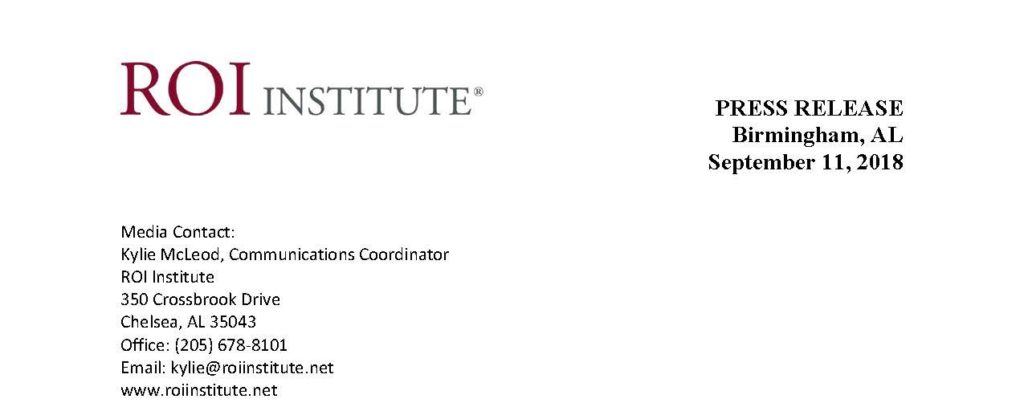Your cart is currently empty!

The Business Value of Leadership Development
Birmingham, Alabama— Recently, we’ve had a flood of inquiries about showing the value of leadership development. In particular, the requests involve conducting ROI studies, showing how to connect leadership development to business from the client perspective, and supporting ROI from the leadership development provider perspective. We see some unfavorable stories surfacing when this is not accomplished very well.
For example, a major leadership development implementation at Scotland Yard in England brought headlines that said, “Met Police Accused of ‘Wasting’ £10 million on Leadership Training Programme as Crime Soars.” In this story, which was a major article in the Sunday Telegraph, the analysis with interviews and information revealed that this leadership development program was implemented by a performance enhancing company called Lane4 Consulting in the UK. The program contained five days of training, 50,000 hours of coaching, 360-degree feedback to gauge the leadership changes, and a personality assessment placing police leaders into red, blue, green, or yellow color categories. At the end of the course, participants were asked to come up with personal pledges, such as “to do more exercise.”
Unfortunately, this program’s implementation came as the crime rate is at an all-time high in London and continues to increase, while the percentage of crimes solved is at an all-time low of five percent. Those are the key business measures that should be, and could be, connected to this leadership program. For some reason, they were not connected. Essentially, the police department and the consulting company both described the success of the program in terms of anticipated leadership behaviors caused by the training, stating only, “We are confident this investment is worthwhile.”
The article was devastating for those who value soft skills and see the need for leadership development to be implemented in organizations. The detailed article probably left the impression with some people that leadership development is a waste. We see it differently.
For a copy of the Scotland Yard article click here.
Leadership development should start with why with very specific business measures. Major leadership efforts cannot be justified in today’s environment just on leader behavior changes, and that was the justification was for the Scotland Yard program. This program was open to all police supervisors, in the role of sergeant and above, including support staff managers. In reality, the key performance indicators of these leaders would be either directly related to these two crime-related categories (crime rate and crimes resolved), or they have impacts that support these measures.
While some will argue that leadership development is not the solution to a crime problem, there are others who would disagree. A recent story published in The Wall Street Journal on August 9, 2018 indicates that the crime problem in Chicago is because of police leadership. It could be, and probably more than likely would be, that part of the reason for the excessive crime is the leadership of Scotland Yard, but the connection was not made.
For a complete copy of the press release click here.
“The key in any major leadership program implementation is to start with why,” explained Patti Phillips, president and CEO of ROI Institute. “The why today is not leader behavior, it has to be business impact. It is a matter of having leaders who are participating in the program identify the measures that they want to change up front, but only if they can change the measures using the leadership competencies that you are offering.”
Progressive organizations are realizing that if you want results, you must design for them. But first, you need to define the success of the results of leadership development. Two decades ago, the definition of success was learning. We wanted to make sure they learned what was necessary to become a good leader. A decade ago, that success was defined as behavior, and we measured that with 360-degree feedback. Today, that success must be defined by impacts, or how the leader behavior is having an impact on the business.
For this to work, the program should start with the end in mind with clear, specific business measures. Next, steps are taken to design for the success that you want, making sure that the right solution is selected, success is expected, the content matters to the group, it sticks on the job, and that you have a credible analysis at the end to make sure that you have the results you need. Then you tell the story with very credible data and use that data to protect and enhance the leadership development budget.
“When we conduct our ROI Certification workshops, which occurs about every week somewhere in the world, leadership development is front and center!” added Jack Phillips, chairman of ROI Institute. “Participants will select a program to evaluate all the way to the impact and ROI. For a group of 20 people, it is not unusual to have four or five leadership development studies. Connecting leadership development to the business is a tremendous issue with clients, and that is who we usually have in the program.”
The good news is that the leadership development providers are now tackling this issue in a very proactive way. They are making sure that they connect leadership development to the business as they initiate the engagement of leadership development in the client organization. Several providers, where the business is based on best-selling books (for example, Multipliers,P1P Spark,P2P and The Four Virtues of LeadershipP3P), are tackling this business connection issue in the beginning with their projects.
For more detail on how this approach is working, click here. For a copy of a case study where this approach is taken for leadership development, click here.
About ROI Institute®
ROI Institute, Inc., founded in 1992 as a service-driven organization, assists professionals in improving programs and processes using the ROI Methodology® developed by Dr. Jack J. Phillips and Dr. Patti P. Phillips. This Methodology is the global leader in measurement and evaluation including the use of return on investment (ROI) in non-traditional applications. ROI Institute regularly offers workshops, provides consulting services, publishes books and case studies, and conducts research on the use of measurement and ROI. This makes ROI Institute the leading source of content, tools, and services in measurement, evaluation, and analytics. Working with more than one hundred ROI consultants, ROI Institute applies the ROI Methodology in 20 fields in over 70 countries. ROI Institute authors have written or edited over 100 books, translated into 38 languages. Organizations build internal capability with the help of ROI Institute and its ROI Certification process. By successfully completing this process, individuals are awarded the Certified ROI Professional® (CRP) designation, which is respected by executives in organizations worldwide. For more information on ROI Institute, please contact info@roiinstitute.net or visit www.roiinstitute.net.
ROI Institute®, ROI Methodology®, Certified ROI Professional® are registered to ROI Institute, Inc. USA and are used by others only with written permission of Jack and Patti Phillips.
References:
- Wiseman, Liz. Multipliers: How the Best Leaders Make Everyone Smarter. (Harper Business, 2017.)
- Ratey, John J. and Eric Hagerman. Spark: The Revolutionary New Science of Exercise and the Brain. (Little, Brown and Company, 2013)
- Kaufmann, Eric. The Four Virtues of a Leader: Navigating the Hero’s Journey Through Risk to Results. (Sounds True, 2016)


























